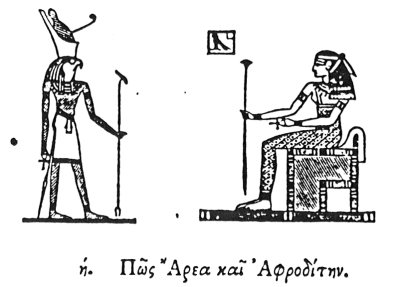
Masonic, Occult and Esoteric Online Library
The Hieroglyphics of Horapollo
By
How Ares and Aphrodite Hor and Hathor

'To denote Ares and Aphrodite (Hor and Athor), they delineate TWO HAWKS; 1 of which they assimilate the male to Ares (Hor), and the female to Aphrodite (Hathor), for this reason, quod ex cæteris animantibus fœmina mari non ad omnem congressum obtemperat, ut in accipitrum genere, in quo etsi tricies in die fœmina a mare comprimatur, ab eo digressa, si inclamata fuerit paret iterum. Wherefore the Egyptians call every female that is obedient to her husband Aphrodite (Hathor), but one that is not obedient they do not so denominate. For this reason they have consecrated the hawk to the sun: for, like the sun, it completes the number thirty in its conjunctions with the female.
When they would denote Ares and Aphrodite (Hor and Athor) otherwise, they depict TWO CROWS [ravens?] as a man and woman; because this bird lays two eggs, from which a male and female ought to be produced, and, ([except?] when it produces two males or two females, which, however, rarely happens,) the males mate with the females, and hold no intercourse with any other crow, neither does the female with any other crow, till death; but those that are widowed pass their lives in solitude. And hence, when men meet with a single crow, they look upon it as an omen, as having met with a widowed creature; and 1 on account of the remarkable concord of these birds, the Greeks to this day in their marriages exclaim, EKKOKI KORI KORONE, though unacquainted with its import.
Footnotes
I. Hor or Horus.
II. Athor, Hathor, or Thyhor, the Egyptian Venus.
16:1 To denote Hor, they delineate a HAWK; and to denote Hathor, a HAWK WITHIN AN ENCLOSURE, as in the figure, which is read as an abode of Horus. Plutarch states that ATHURI signifies Horus's mundane house.
18:1 Treb. omits the concluding sentence from ζ??
